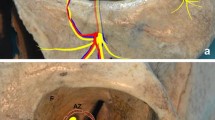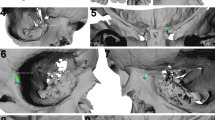Abstract
Purpose
To describe the relationship of the orbital rim and depth in Far Eastern skulls by anatomical study, using morphometry to yield an octagonal three-dimensional model of the orbit.
Methods
Forty-one orbits of 21 Far Eastern skulls from the Department of Anatomy of St George’s, University of London were included in this study. A morphometric study was conducted, measuring between eight reproducible orbital rim landmarks to yield perimeters, and from these landmarks to the optic canal to yield orbital depth. Orbital height and width were also recorded. Results were statistically analysed to look for evidence of gender variation or laterality before comparison with those from other ethnicities. The authors then present a method for three-dimensional description of the orbit.
Results
67 % of orbits were male. Orbital height and width were significantly greater in males (34.6 ± 2.0 and 39.4 ± 1.7, vs. 32.5 ± 2.3 and 37.2 ± 2.4 mm). Orbital perimeter tended towards being larger in males (126.3 vs. 122.2 mm, p = 0.05), as was the angle between medial and lateral walls (50.1° ± 2.0°, vs. 47.9° ± 3.0°).
Conclusion
This study has proposed a new method for describing the orbit using three-dimensional measurements, yielding clinically useful morphometric data. These results and model have applications in surgical navigation of the orbit, repair of fractures, and prediction of post-traumatic or surgical enophthalmos.



Similar content being viewed by others
References
Bekvalac J (2012) Sex determination. In: Powers N (ed) Human osteology method statement. Museum of London. Available via Museum of London. http://archive.museumoflondon.org.uk/NR/rdonlyres/3A7B0C25-FD36-4D43-863E-B2FDC5A86FB7/0/OsteologyMethodStatementrevised2012.pdf. Accessed 11 Aug 2015
Borumandi F, Hammer B, Noser H, Kamer L (2013) Classification of orbital morphology for decompression surgery in Graves’ orbitopathy: two-dimensional versus three-dimensional orbital parameters. Br J Ophthalmol 97(5):659–662. doi:10.1136/bjophthalmol-2012-302825
Burnstine MA (2003) Clinical recommendations for repair of orbital facial fractures. Curr Opin Ophthalmol 14(5):236–240
Gentile MA, Tellington AJ, Burke WJ, Jaskolka MS (2013) Management of midface maxillofacial trauma. Atlas Oral Maxillofac Surg Clin North Am 21(1):69–95. doi:10.1016/j.cxom.2012.12.010
Hoşal BM, Beatty RL (2002) Diplopia and enophthalmos after surgical repair of blowout fracture. Orbit 21(1):27–33. doi:10.1076/orbi.21.1.27.2598
Hwang K, Baik SH (1999) Surgical anatomy of the orbit of Korean adults. J Craniofac Surg 10(2):129–134
Ji Y, Qian Z, Dong Y, Zhou H, Fan X (2010) Quantitative morphometry of the orbit in Chinese adults based on a three-dimensional reconstruction method. J Anat 217(5):501–506. doi:10.1111/j.1469-7580.2010.01286.x
Karakaş P, Bozkir MG, Oguz O (2003) Morphometric measurements from various reference points in the orbit of male Caucasians. Surg Radiol Anat 24(6):358–362. doi:10.1007/s00276-002-0071-0
Kolk A, Pautke C, Schott V, Ventrella E, Wiener E, Ploder O, Horch HH, Neff A (2007) Secondary post-traumatic enophthalmos: high-resolution magnetic resonance imaging compared with multislice computed tomography in postoperative orbital volume measurement. J Oral Maxillofac Surg 65(10):1926–1934. doi:10.1016/j.joms.2006.06.269
Manolidis S, Weeks BH, Kirby M, Scarlett M, Hollier L (2002) Classification and surgical management of orbital fractures: experience with 111 orbital reconstructions. J Craniofac Surg 13(6):726–737
Tahernia A, Erdmann D, Follmar K, Mukundan S, Grimes J, Marcus JR (2009) Clinical implications of orbital volume change in the management of isolated and zygomaticomaxillary complex-associated orbital floor injuries. Plast Reconstr Surg 123(3):968–975. doi:10.1097/PRS.0b013e318199f486
Weaver AA, Loftis KL, Tan JC, Duma SM, Stitzel JD (2010) CT based three-dimensional measurement of orbit and eye anthropometry. Invest Ophthalmol Vis Sci 51(10):4892–4897. doi:10.1167/iovs.10-5503
Acknowledgments
The authors would like to thank Jelena Bekvalac, Curator of Human Osteology at the Museum of London, for her time and expertise in forensically evaluating the specimens.
Author information
Authors and Affiliations
Corresponding author
Ethics declarations
Ethical standards
The authors confirm that this work has been conducted in accordance with the laws of the United Kingdom, where it was performed.
Conflict of interest
The authors declare that they received no funding for this research. Messiha is currently employed by St George’s Hospital. Fitzhugh and Naveed have previously received payment for employment by St George’s Medical School, for work unrelated to this research.
Rights and permissions
About this article
Cite this article
Fitzhugh, A., Naveed, H., Davagnanam, I. et al. Proposed three-dimensional model of the orbit and relevance to orbital fracture repair. Surg Radiol Anat 38, 557–561 (2016). https://doi.org/10.1007/s00276-015-1561-1
Received:
Accepted:
Published:
Issue Date:
DOI: https://doi.org/10.1007/s00276-015-1561-1




